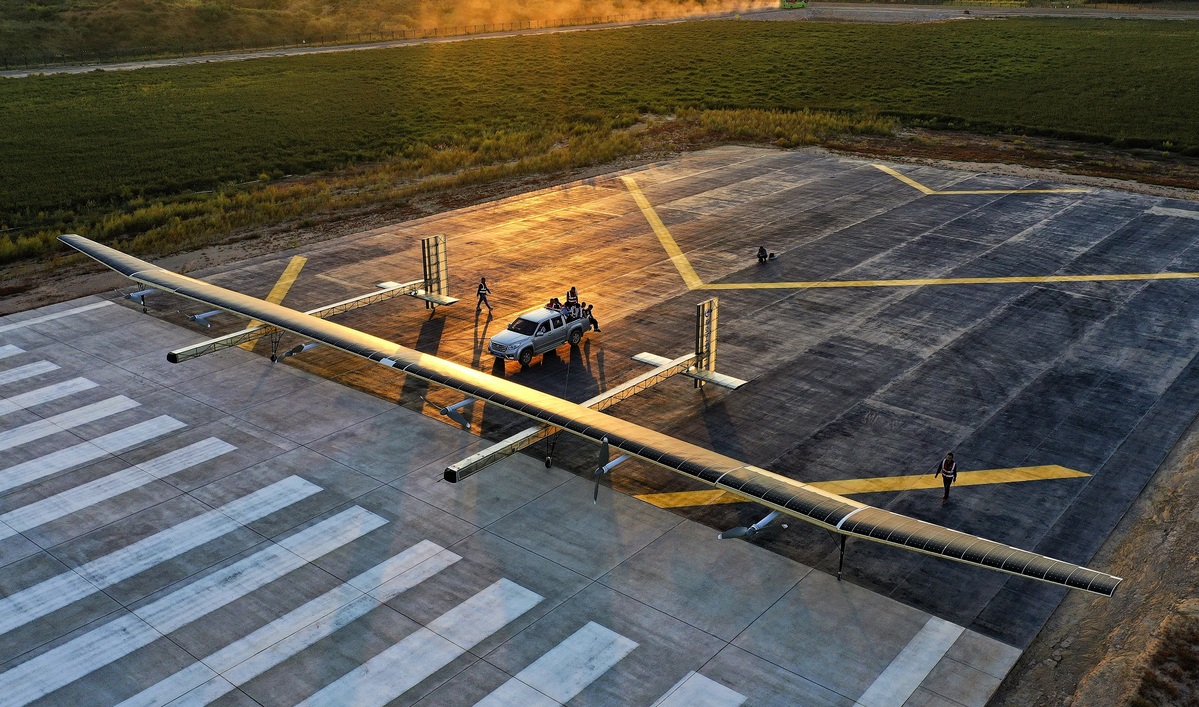China’s top aircraft manufacturer, Aviation Industry Corp of China (AVIC), announced on September 3 that the nation’s first large, fully solar-powered drone completed its inaugural flight. This accomplishment represents a significant step forward in developing an all-electric, large unmanned aerial vehicle platform.
‘Target Destroyed’: 269 People Killed Including A Top US Democrat – Why Did Soviet Russia Shoot Down A Passenger Plane In 1983?
Straight Out Of Sci-Fi! Meet ‘Darkstar’ Strategic Bomber That Could Have Been The Greatest Aircraft To Have Ever Flown!
The state-run Global Times reported, citing AVIC, that the Qimingxing 50, also known as the Morning Star 50, ascended to the skies at 5:50 pm on September 3 from an airport in Yulin, Shaanxi Province.
The drone was in the air for 26 minutes before landing on the same runway.
The aircraft conducted its maiden flight smoothly, with all systems functioning normally. The Qimingxing-50 is the first major unmanned aerial vehicle platform that is all-electric and solely powered by solar energy.
Qimingxing(Morning Star) 50 has made its debut. The fully solar-powered drone, developed by Aviation Industry Corp of China, is designed to fly at an altitude of up to over 20 km and stay airborne “as long as controllers wish” like a "quasi-satellite", Chinese media reported. pic.twitter.com/6DPITJFh85
— Juan Yong (@JuanYong_JY) September 4, 2022
It is also the first high-altitude, low-speed drone with an ultrahigh aspect ratio produced by the Chinese aviation sector. The manufacturer said the drone could stay in the air for an extended period using efficient, clean, and environmentally-friendly solar energy.
The drone is intended to operate for long-time operations in near space and is propelled by six electric motors driven by solar batteries.
Near space refers to the region of Earth’s atmosphere between 20 and 100 kilometers above the surface, which includes the stratosphere, mesosphere, and lower thermosphere. It is lower than orbiting satellites yet higher than the top altitudes of commercial aircraft.

The drone can fly up to an altitude of nearly 20 kilometers and stay airborne overnight. Zhu Shengli, the chief designer of Qimingxing 50, explained that the solar panels are mounted on the wings, which measure 50 meters in length together.
The drone will also benefit from advancing science and technology in composite materials, aeronautical engineering, and new energy. The designer noted that it would enhance the nation’s ability to operate close to the oceans.
Can This Drone Also Function As A Satellite?
Shengli referred to the model as a “quasi-satellite,” noting that it will be used for high-altitude surveillance, forest fire monitoring, atmospheric environmental inspection, aerial mapping, communication signal relay, and other tasks.
A Chinese aerospace expert told the Global Times that the Qimingxing 50 drone could essentially take the place of satellites due to its ability to undertake long endurance missions in near space.
The expert noted that satellite systems could also be compromised during times of war; thus, near-space drones can take their place during such events. The expert added that near-space drones could compensate for these drawbacks for time-sensitive operations.
The expert added that a satellite is more expensive than an airborne drone. The Chinese People’s Liberation Army Air Force has already operated the WZ-8 high-altitude reconnaissance drone. That drone is capable of fast, near-space flight but has limited endurance.
The Qimingxing 50’s successful test flight sets the stage for the growth and type establishment of big solar-powered unmanned aerial vehicles in China’s aviation sector.
The Chinese aviation sector will reap the benefits of increasing investments in cutting-edge research and development, speeding up the creation of large solar-powered unmanned aircraft. It will also continue to set the pace for independent innovation in related sectors.
Wu Peixin, a Beijing-based aviation industry watcher, noted that there are no clouds at an altitude of 20,000 meters or higher, and the airflow is stable, enabling the drone to completely utilize its solar cells for power generation.
Earlier, China’s two main space contractors, China Aerospace Science and Technology Corp and China Aerospace Science and Industry Corp, designed and produced solar-powered drone models that could fly in near space.
Several nations have built solar-powered drones that can soar as high as 20,000 meters, including the United States and the United Kingdom. In August 2001, the US Helios model, manufactured by the technology company AeroVironment Inc in California, set a new record for the highest altitude a solar-powered drone has ever reached – 29,524 meters.
The Helios Prototype is a remotely controlled flying wing aircraft developed under NASA’s Environmental Research Aircraft and Sensor Technology (ERAST) program.
- Contact the author at ashishmichel@gmail.com
- Follow EurAsian Times on Google News